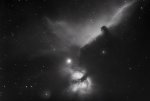It can be fairly complicated and I use some expensive kit for an Amateur, but it can be done cheaper.
I use a computer controlled tripod / mount (About £2,000) that follows the stars precisely was they move through the sky. I also use a guiding telescope for even better tracking. I then have an 8inch F2.4 (£2500) Newtonian telescope with a custom cooled (-20 degrees) CCD camera (£2000)
My shots are about 10 hours in exposure in stacks of 10 - 15 minutes (hence the precise guiding / tracking needed to maintain a clear picture). All of these images are stacked together and then processed to give the final image (takes about 3 hours to stack and process manually)
It can be done much cheaper with a DSLR and a tripod, but you have to reduce the exposures to about 5 seconds each (instead of 10 minutes) and of course the results are much different.
Try the following
1. Get a DSLR with a 50mm lens at set it to as low as F stop you can and set focus to infinity
2. Put it on a tripod and point it at Orion on a clear "Dark" night with no street or house lights about. Best to get out of town
3. Set the ISO to 8000
4. Set exposure to 10 seconds.
5. Take many pictures. Use a remote shutter control with a time delay to reduce shaking.
6. Download DSS (Deep Sky Stacker) freebie
7. Stack images
8. Process in Photoshop by adjusting balances / colour etc etc.
This is a relatively simple and cheap way of getting something nice and wide field.
It is a great hobby, but be warned, it is addictive and a money pit if you let it be.



